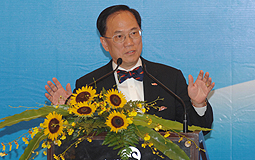
|
| Bridge breakthrough: Chief Executive Donald Tsang briefs the media on the tentative financing arrangement for the Hong Kong-Zhuhai-Macau Bridge. |
Hong Kong, Guangdong and Macau have agreed to mutually fund the construction of the Hong Kong-Zhuhai-Macau Bridge, which will also see a contribution from the Central Government.
The announcement was made at the 11th Plenary of Hong Kong-Guangdong Co-operation Joint Conference in Guangzhou today. Boundary crossing facilities and link roads to the bridge will be funded by each jurisdiction within their boundaries.
Hong Kong will contribute 6.75 billion yuan with the Guangdong-Central Government contribution of seven billion, while Macau will pay 1.98 billion. The three sides' total contribution will be 15.73 billion yuan or 42% of the bridge's construction cost. The remainder will be financed by bank loans.
Co-operation milestone
Speaking at the conference today Chief Executive Donald Tsang hailed the three governments' consensus as a major breakthrough, adding the submission of a feasibility study report can now be expedited. There will also be better control over the bridge's tolls, maximising economic benefits, he added. Construction of the bridge will start by 2010.
However, he said the exact contribution from each government is subject to change depending on the feasibility study. The new arrangement will also involve funding applications and approval in the three jurisdictions.
The next step is for the formulation of a formal agreement and institutional setup for the project. Hong Kong will tender out the bridge's design work after getting the Legislative Council Finance Committee's endorsement.
Cross-boundary ties
Mr Tsang said Hong Kong and Guangdong will push forward other large-scale cross-boundary infrastructure like the Guangzhou-Shenzhen-Hong Kong Express Rail Link, the proposed Liantang-Heung Yuen Wai control point, and co-operation between Hong Kong and Shenzhen airports.
The two sides not only reaffirmed to achieve the 2010 emission reduction targets as earlier agreed, but will also explore the concept of jointly transforming the Greater Pearl River Delta Region into a "Green Quality-Living Sphere". This will include formulating a set of jointly-accepted air quality objectives and post-2010 emission reduction targets.
Both sides will study how to facilitate the adoption of cleaner production in the delta region, and to jointly develop cleaner energy production and renewal, a circular economy and green industries.
They will enhance power-generation composition, the region's water quality, nature conservation, greening and public education. Guangdong has already embarked on a study on such a living-sphere concept.
Trade co-operation
The two governments signed Supplement V to the Hong Kong-Mainland Closer Economic Partnership Arrangement last week and will enhance exchanges, promotion and support to service suppliers, formulate implementation details and rules, and establish a notification and discussion mechanism.
Mr Tsang said another main focus will be to help Hong Kong-owned firms in Guangdong to evolve and upgrade. He thanked the Guangdong government for introducing a 40 billion yuan package to help these firms relocate and restructure without production interruption.
Other issues
The two sides agreed to allow Hong Kong service providers to operate welfare service agencies for the disabled in the form of wholly-owned private non-government firms in Guangdong on a pilot basis.
An expert group will be formed under the joint conference to enhance Hong Kong-Guangdong co-operation in emergency management.
And on education, Hong Kong will discuss with Guangdong implementing a new exchange programme for local junior secondary and senior primary students. Hong Kong and Shenzhen will also launch a trial scheme enabling two Shenzhen schools to join Hong Kong's secondary school places allocation system to provide a better arrangement for children of Hong Kong residents living and studying in Shenzhen when they return to the city to further their studies.
|